-

A road next to fields of “tam giac mach” (buckwheat) flower leading to Ha Giang. The flower is often planted around September. In the last months of the year, the province becomes more picturesque as buckwheat flowers are in full bloom and embraced by sunshine. The hills and mountains are covered by the white and pink of the flower. Beautiful buckwheat flower fields, framed by magnificent limestone mountains, have become attractive destinations for tourists to Ha Giang province in recent years. Buckwheat is cultivated for its grain-like seeds, which are used to make specialty food by ethnic minorities in the mountainous region. The flower symbolises love and happiness, so many couples shoot their wedding photos in these fields. (Photo: VietnamPlus)
-

The buckwheat flower with a silhouette from distance. Ha Giang is loved by many for its spectacular sight of buckwheat flower fields amid the karst plateau in September and October. Tourists become spellbound by the magnificent rocky plateaus, winding passes, picturesque terraced fields that paint the valleys with yellow colour in harvest season and mirror the sky colours in the sowing season, and especially enchanting buckwheat flower fields. Over the past years, Ha Giang has become an attractive destination for both domestic and foreign holidaymakers whose number increased 14 percent each year during the 2010-2015 period, and 14.6 percent between 2015 and 2020, contributing 8.8 percent to the local gross regional domestic product (GRDP). (Photo: VietnamPlus)
-

A field of buckwheat flower in Ha Giang. Wanderlusts understand fully that Ha Giang is beautiful all the year round and every season promises different experience for visitors. The mountainous province has a population of 800,000, 90 percent of whom are ethnic minorities with their unique culture and lifestyle. One of the most beautiful sites in the province is the Dong Van Karst Global Geopark, designated by UNESCO as one of 77 sites with important geological and cultural value. The geopark is littered with ethereal karst formations that are nearly 400 million years old. Most of the Dong Van Karst Plateau’s surface is limestone (about 60 percent). (Photo: VietnamPlus)
-
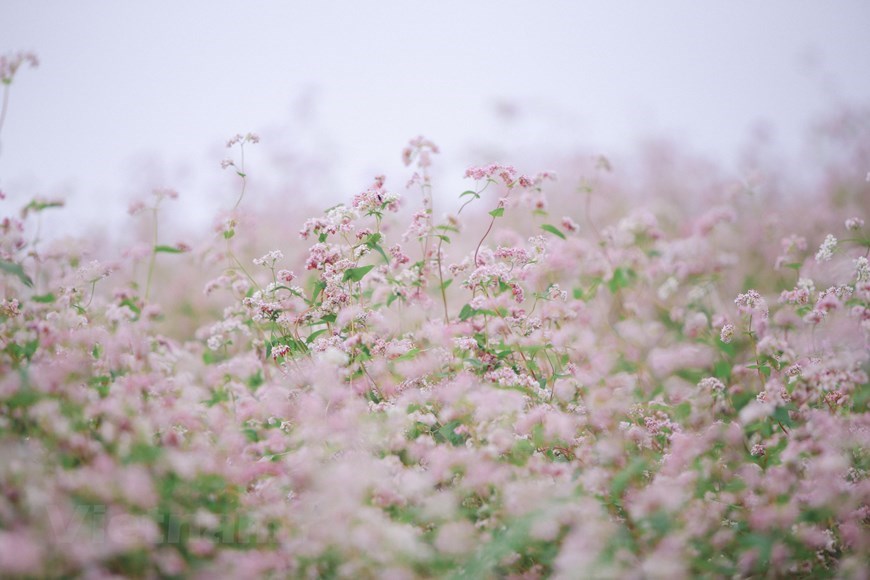
Extending fields of buckwheat flower are a highlight of Ha Giang. Buckwheat is cultivated for its grain-like seeds, which are used to make specialty food by ethnic minorities in the mountainous region. Year-end is the time when buckwheat flower fields burst into full bloom, embellishing the beauty of Ha Giang, located in the far north of Vietnam. The hills and mountains are covered by the white and pink of the flower. The flower symbolises love and happiness, so many couples shoot their wedding photos in these fields. Those who travel to Ha Giang but have yet to visit the buckwheat flower fields are believed to fall into a long time of regret. (Photo: VietnamPlus)
-

A local elderly woman and two girls wearing baskets filled with flowers stand amid a buckwheat flower field. The flower, primarily in the colours of pink and purple, seems tiny and fragile embraced by gigantic mountains of Ha Giang, fascinating visitors with spectacular scenery. The flower symbolises love and happiness, so many couples shoot their wedding photos in these fields. Meanwhile, the buckwheat flower festival has been regarded as a highlight for years to promote local culture. Capitalising on tourists’ demand, many local residents have invested in buckwheat flower fields offering check-in services, with entrance ticket fees ranging only from 10,000 VND to 20,000 VND (0.45 – 0.9 USD) per person. (Photo: VNA)
-

Three young ethnic girls smile brightly and innocently next to a buckwheat flower field, with baskets of flowers on their backs. Ethnic girls standing amid a buckwheat flower field is a scene fancied by many tourists. Visitors can take photos with local children. The north western mountainous province of Ha Giang is home to about 20 ethnic minority groups with unique cultural identities and festivals. Over the past years, the province has become an attractive destination for both domestic and foreign holidaymakers whose number increased 14 percent each year during the 2010-2015 period, and 14.6 percent between 2015 and 2020, contributing 8.8 percent to the local gross regional domestic product (GRDP). (Photo: VietnamPlus)
-

A girl smiles radiantly with a basket full of flowers amid a vast buckwheat flower field. The grandiose Dong Van Karst Plateau has a gentle and elegant side thanks to flowers that bloom on rocks. The Dong Van Karst Global Geopark, designated by UNESCO as one of 77 sites with important geological and cultural value, is littered with ethereal karst formations that are nearly 400 million years old. In 2010, the geopark was recognised as the first Global UNESCO Geopark of Vietnam and the second in Southeast Asia after the Langkawi of Malaysia. It has two natural conservation areas rich in fauna and flora species, including many species of bird. (Photo: VietnamPlus)
-

Buckwheat flowers up close. On early days of winter, the mountains seem to change its colours to purple, white and pink of buckwheat flower. Buckwheat is cultivated for its grain-like seeds, which are used to make specialty food by ethnic minorities in the mountainous region. Year-end is the time when buckwheat flower fields burst into full bloom, embellishing the beauty of Ha Giang, located in the far north of Vietnam. The flower symbolises love and happiness, so many couples shoot their wedding photos in these fields. Those who travel to Ha Giang but have yet to visit the buckwheat flower fields are believed to fall into a long time of regret. (Photo: VietnamPlus)
-

The pink ‘carpet’ of buckwheat flower field on the mountains. The flower is in bloom at year-end. Ha Giang’s landscape is spectacular and unique having high mountains and deep canyons. The highest peak is Mieu Vac Mount (1,971m) while Tu San is the deepest canyon (700-800 m deep). It is home to 17 ethnic groups, creating the unique and rich cultural heritage of this area. Dong Van Karst Global Geopark was recognised as the first Global UNESCO Geopark of Vietnam and the second in Southeast Asia after the Langkawi of Malaysia. UNESCO’s recognition has created new opportunities for socio-economic development in Ha Giang and four districts in the karst plateau area in particular. Meanwhile, the buckwheat flower festival has been regarded as a highlight for years to promote local culture. (Photo: VietnamPlus)
-

Buckwheat flowers. The plant also heralds Ha Giang’s tourist season which is also the time when the scenery here is at its finest. The hills and mountains are covered by the white and pink of the flower. In addition, Ha Giang owns various historical relic sites and landscapes such as the Heaven’s Gate and Quan Ba twin mountains (in Quan Ba district); the Vuong family palace and Lung Cu national flagpole (Dong Van district); Ma Pi Leng Pass (Meo Vac district); Tien waterfall – Gio pass and the ancient rock field of Nam Dan (Xin Man district); and Quang Ngan mineral stream in Vi Xuyen district. (Photo: VietnamPlus)
-

A stretching buckwheat flower field with mountain peaks in the background. Buckwheat is cultivated for its grain-like seeds, which are used to make specialty food by ethnic minorities in the mountainous region. The flower usually blooms in late autumn. Some can catch the sight of the flower even after the Tet (Lunar New Year) holiday. The buckwheat flower festival has been regarded as a highlight for years to promote local culture. Over the past years, Ha Giang has become an attractive destination for both domestic and foreign holidaymakers whose number increased 14 percent each year during the 2010-2015 period, and 14.6 percent between 2015 and 2020, contributing 8.8 percent to the local gross regional domestic product (GRDP).(Photo: VietnamPlus)
-

Mountain peaks can be seen from the buckwheat flower field. From Quan Ba, Yen Minh to Meo Vac, Dong Van, tourists can enjoy the flower carpet of nature snaking along mountains and hills, creating a scene which is spectacular and poetic at the same time. The highest peak in Ha Giang is Mieu Vac Mount (1,971m) while Tu San is the deepest canyon (700-800 m deep). Tu San canyon is deemed the deepest one in Vietnam in particular and Southeast Asia in general. It is home to cliffs measuring up to 800m in height, 1.7km in length and 900m in depth, thereby one of the most outstanding destinations of Dong Van rock plateau (Photo: VietnamPlus)
-

Buckwheat flower has been grown in many areas in Ha Giang province. Beautiful fields of buckwheat flower, framed by magnificent limestone mountains, have become a can-not-miss attraction for tourists in the province in recent years. Capitalising on tourists’ demand, many local residents have invested in buckwheat flower fields offering check-in services, with entrance ticket fees ranging only from 10,000 VND to 20,000 VND (0.45 – 0.9 USD) per person. Ha Giang has been endowed with many magnificent unspoiled landscapes. With the aim of turning difficulties into momentum for development, the local authorities and ethnic people have constantly made great efforts and worked together to reduce poverty. (Photo: VietnamPlus)
-
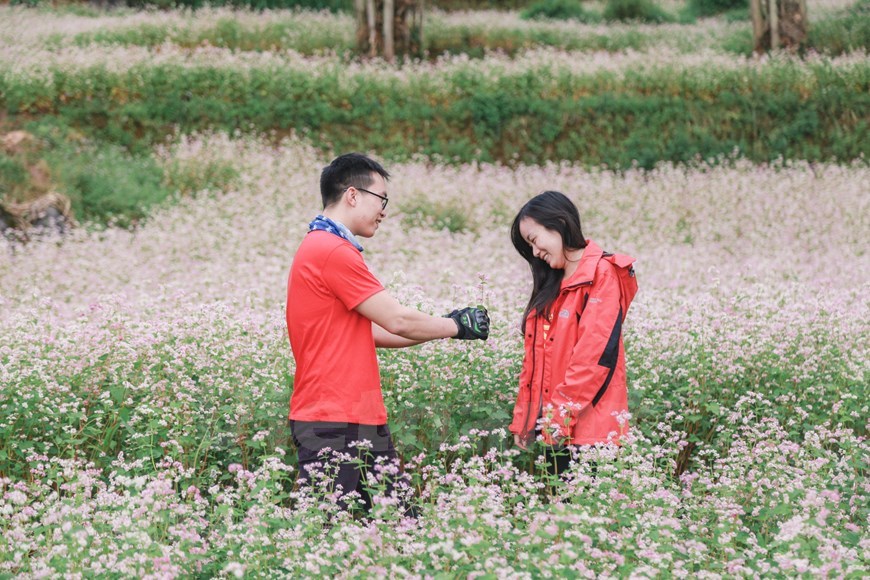
A couple stand on a field of buckwheat flower. Travelling to the site in October and November, visitors will have the chance to enjoy the beauty of buckwheat flower blossoming season. The hills and mountains are covered by the white and pink of the flower. The flower symbolises love and happiness, so many couples shoot their wedding photos in these fields. Young people have chosen Ha Giang as an unmissable destination in their journey to explore the beauty of the northeastern part of Vietnam. The region spreads over nine provinces of Phu Tho, Ha Giang, Tuyen Quang, Cao Bang, Bac Kan, Thai Nguyen, Lang Son, Bac Giang and Quang Ninh.(Photo: VietnamPlus)
-

Fields of buckwheat flower in the colours of pink and white. To enjoy the peaceful landscape together with chilly weather in the mountainous region of Vietnam is an irreplaceable experience. Wanderlusts understand fully that Ha Giang is beautiful all the year round and every season promises different experience for visitors. The Dong Van Karst Global Geopark, designated by UNESCO as one of 77 sites with important geological and cultural value, is littered with ethereal karst formations that are nearly 400 million years old. It has two natural conservation areas rich in fauna and flora species, including many species of bird such as conifers, Asian black bear, Southern serow (a solitary mountain goat). (Photo: VietnamPlus)
-

The scenery of the mountainous region is adorned by the dreamy charms of fields of ‘tam giac mach’, or buckwheat flower. UNESCO’s recognition of the Dong Van Karst Global Geopark as one of 77 sites with important geological and cultural value has created new opportunities for socio-economic development in Ha Giang and four districts in the karst plateau area in particular. With the aim of turning difficulties into momentum for development, the local authorities and ethnic people have constantly made great efforts and worked together to reduce poverty. Over the past years, Ha Giang has become an attractive destination for both domestic and foreign holiday-makers. (Photo: VietnamPlus)
-

Coming to Ha Giang, tourists can contemplate the flower at the foot of Ma Pi Leng Pass, Lung Cu Flag Tower, and Lung Cam cultural village, among others. The highest peak in Ha Giang is Mieu Vac Mount (1,971 m) while Tu San is the deepest canyon (700-800 m deep). Tu San canyon is deemed the deepest one in Vietnam in particular and Southeast Asia in general. It is home to cliffs measuring up to 800m in height, 1.7 km in length and 900 m in depth, thereby one of the most outstanding destinations of Dong Van rock plateau formed millions of years ago, Tu San canyon is believed to be a wonder of nature. (Photo: VietnamPlus)
-
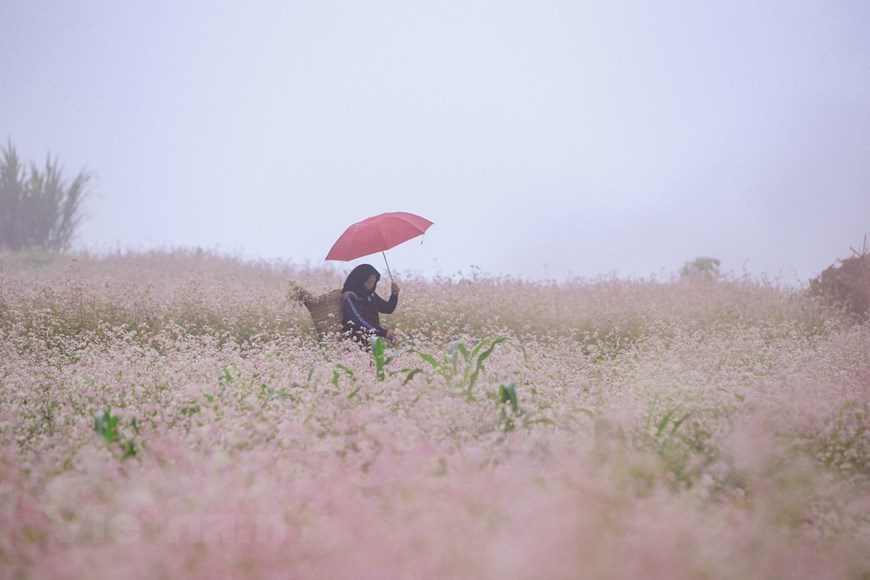
The flower is often planted around September and blooms between October and December. In the last months of the year, Ha Giang province becomes more picturesque as buckwheat flowers are in full bloom and embraced by sunshine. The hills and mountains are covered by the white and pink of the flower. Beautiful fields of buckwheat flower, framed by magnificent limestone mountains, have become attractive destinations for tourists in Ha Giang in recent years. Buckwheat is cultivated for its grain-like seeds, which are used to make specialty food by ethnic minorities in the mountainous region. Those who travel to Ha Giang but have yet to visit the buckwheat flower fields are believed to fall into a long time of regret. (Photo: VietnamPlus)
-

An elderly woman smiles happily as she is surrounded by ‘tam giac mach’ flowers. The variety in Ha Giang differentiates itself from others by its pinkish colour. The flower forms large fields along mountainous roads and valleys, and even grows on jagged cliffs. The maleficent beauty of the gigantic cliffs of Ha Giang is coupled with the romantic and poetic scene of the buckwheat flower fields. Ha Giang province has a population of 800,000, 90 percent of whom are ethnic minorities with their unique culture and lifestyle. The province draws tourists with its endless terraced rice fields, buckwheat flower fields and grandiose mountain landscapes. (Photo: VietnamPlus)
-
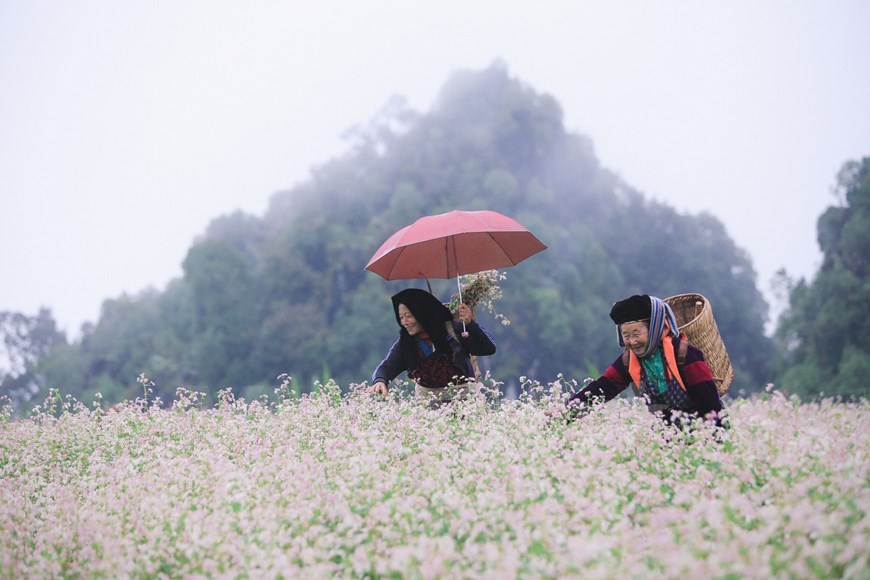
It is said that once upon a time, the habitats in northern mountainous areas mainly lived on corn and rice until one day, all corn and rice in the house were nearly exhausted but the fields could not be harvested. The villagers were very hungry. Suddenly, they smelt a a scent in the wind. They went along the ravine and found a field of tiny flowers with triangle-shaped leaves. The villagers brought seeds of the flowers home to substitute for corn and rice and called them tam giac mach. Since then, tam giac mach was used as ingredient for bread or mixed with corn to make wine such as Ban Pho wine in Bac Ha, Nam Pung wine in Bat Xat. (Photo: VietnamPlus)
-

Going through 500km of roads from Hanoi to Dong Van ancient town of Ha Giang, tourists will feel that it is worth a trip as they will surely be satisfied by the majestic scene of massive “tam giac mach” fields. There are many places to contemplate tam giac mach flower such as Simacai, Bat Xat, Muong Khuong districts in Lao Cai province, Tra Linh, Trung Khanh districts in Cao Bang province. However, the most popular destination is Ha Giang province with familiar names like Sung Lan, Lung Cu, Xin Man. Normally, the flower blooms in late October, early November depending on the cultivating time. Tam giac mach flower often has three colours including light pink, glistening purple and dark red. Particularly, most of tam giac mach flowers in Cao Bang are white. (Photo: VietnamPlus)
-

Ha Giang has normally held an annual Tam Giac Mach Flower Festival in October when the flower is in full bloom and most beautiful. The festival will be held along with a chain of cultural activities such as a H’mong flute festival, a amateur photo exhibition with subjects about Dong Van highland, rock plateau tourism fair. This is a chance for Ha Giang to promote and advertise the special characteristics, local traditional culture of ethnic minority groups living in the area Global Geopark Dong Van. However, this year, the COVID-19 complicated developments have posed many difficulties for the locality in organising the event. (Photo: VietnamPlus)
-

Facing complex developments of the COVID-19 pandemic both domestically and abroad, many tourism firms in the northern province of Ha Giang have sketched an array of measures to overcome difficulties and maintain their business. For large tourism companies like H’Mong Village, they have suffered greater loss due to huge investment. All customers of H’Mong Village have cancelled their bookings since the fourth wave of COVID-19. Due to the pandemic, cultural, sport and tourism events in Ha Giang were cancelled in the first half of the year, critically affecting business of travel firms and lodging facilities. Ha Giang province hosted more than 642,000 arrivals in the first half of this year, equivalent to 38 percent of the set plan. (Photo: VietnamPlus)
-

Buckwheat flower fields often burst into full bloom from October to the end of winter. Although buckwheat flowers are small, they have strong vitality. In the arid rocky areas, they still thrive and gloriously bloom. Any visitors will be blown away by the romantic beauty of buckwheat flower fields. Buckwheat is cultivated for its grain-like seeds, which are used to make specialty food by ethnic minorities in the mountainous region. The flower symbolises love and happiness, so many couples shoot their wedding photos in these fields. The flower has become a symbol of the natural beauty of northwest mountainous region and Ha Giang province in particular. (Photo: VietnamPlus)
-

The locals sow buckwheat seeds on Dong Van Plateau in March, May, August and December of the lunar calendar. There are two types of buckwheat flowers. In areas of Cao Bang, the white type is popular. Meanwhile, in Ha Giang, people often plant the purple buckwheat flower. Simple but loveable, modest but charming, buckwheat flower is harmonious with the green colour of the forest and the grey colour of the mountains which altogether creates an endless source of inspiration for art enthusiasts. But the most profound and beautiful feature of the flower is its meaning – slender in shape but full of energy and beauty, always overcoming the fierce challenges of nature. (Photo: VietnamPlus)
-
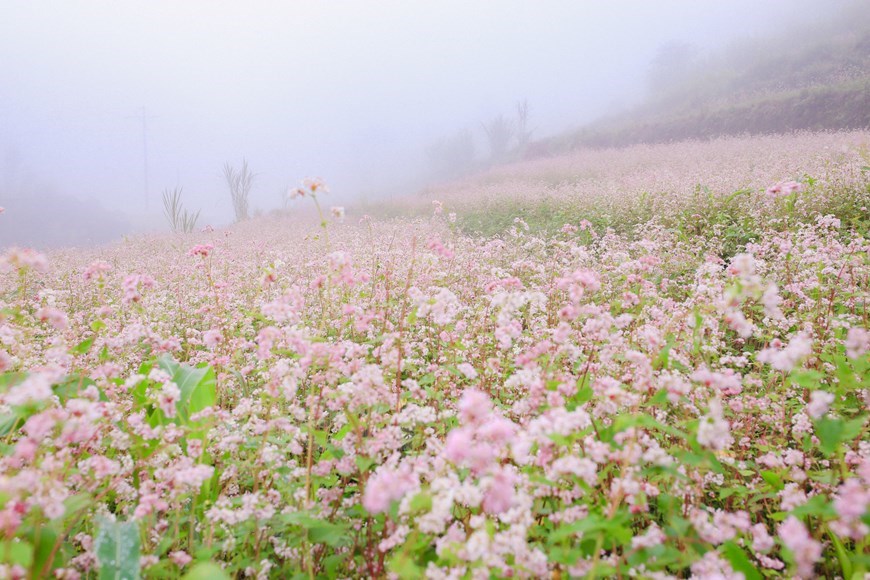
As autumn reaches its end, the flowers become more splendid and attractive. With time, they will start to change colour from white to purple pink, and finally dark red. Buckwheat is often considered as a tasty and healthier alternative to wheat. When harvested, the crops can be ground into flour. Rice, porridge, noodles, breads, pancakes, cookies, cakes, can all be made from buckwheat flour. The young buckwheat flower stem can also be boiled and used as vegetables, or it can be cooked with wine and corn to brew a very unique type of wine. It also has medicinal benefits and is sometimes used as trunk for cattle feed. (Photo: VietnamPlus)
-
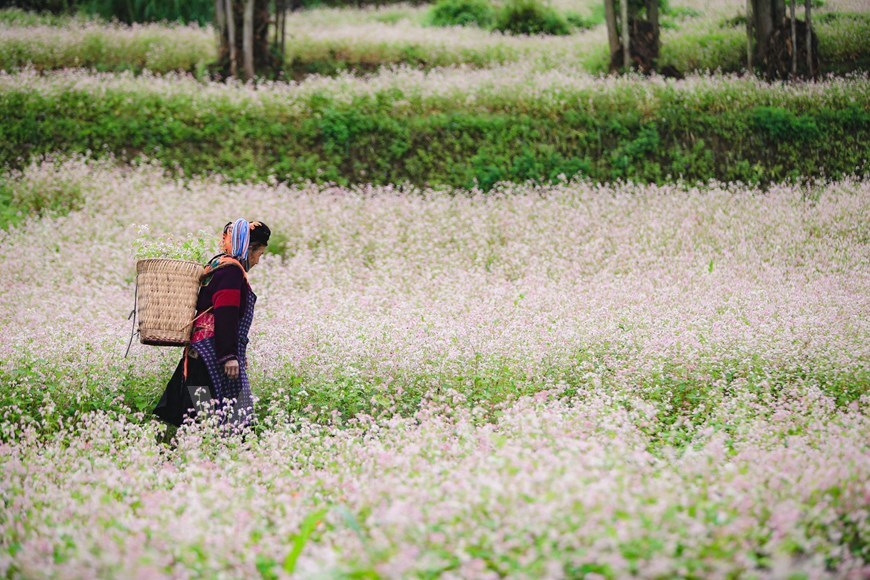
According to the legend, in the past, the people in the northern mountainous region lived mainly on rice and corn. One year, the food ran out and the land had become barren, and the local people had to wander in search of food. Then, a strange yet pleasant fragrance filled the atmosphere and attracted the peasants to follow the ravine. Among the rocks, they discovered small white pink flowers whose nuts tasted as subtle as rice and corn. Since then, the H’mong have used the buckwheat flowers’ nuts as staples like maize and rice. The buckwheat flower then became an essential part of their daily lives. (Photo: VietnamPlus)
-

The flowers of the buckwheat plant have a pleasant fragrance and tastes quite malty and earthy. The flowers are used for manufacturing a dark brown-colored honey that is quite strong in flavor. Buckwheat has many nutritional benefits and is a good source of high-quality protein that easy to digest. The buckwheat starch acts as fat in processed foods, which is why it is used in bakery. Other benefits include that it lowers blood pressure as it is a good source of rutin, is non-allergenic (stuffed into pillows to help cure dust, feather and pollen allergies), helps manage diabetes, is good for digestion, is gluten-free, reduces cholesterol, lowers blood sugar levels, protects against breast cancer, benefits the skin and hair, among many other things. (Photo: VietnamPlus)
-

In the midst of rolling hills, mountains and rocks, Sung La is beautiful, gentle and romantic with the colours of flowers and grasses during the season of buckwheat flowers. Buckwheat flowers, with three colours of white, pink and purple, blanket all the mountain slopes and the valley. The flowers bloom within a month. However, local farmers have planted successive series of flowers to beautify the land of gray rocks throughout the autumn. This kind of flower has been favoured not only for its romantic beauty but also for its intense vitality. They still rise strongly despite the barren soil and the cold weather. (Photo: VietnamPlus)
-

Ethnic minority kids carry a basket full of buckwheat flowers on their backs. Lung Cu flagpole is the best place to see buckwheat flowers. The flowers are grown in extremely eye-catching terraced fields giving tourists the most unforgettable scene of their life. Other locations to witness the endless fields of buckwheat flowers in Ha Giang are Pha Cao, Dong Van, Ma Le, Hoang Su Phi, Xin Man, and Pho Bang. Last year, the world’s leading online booking platform Hostelworld placed Ha Giang at the 13th position among its 20 must-see destinations for 2020. Ha Giang was one of the 10 most sought-after destinations among Vietnamese Googlers in 2019, according to Google’s year-end trend report. (Photo: VietnamPlus)
Magnificent Ha Giang in buckwheat flower season
Travelling to the norther mountainous province of Ha Giang between September and December, tourists will be mesmerised by extending fields of buckwheat flower which are similar to a soft and lovely pink carpet.



